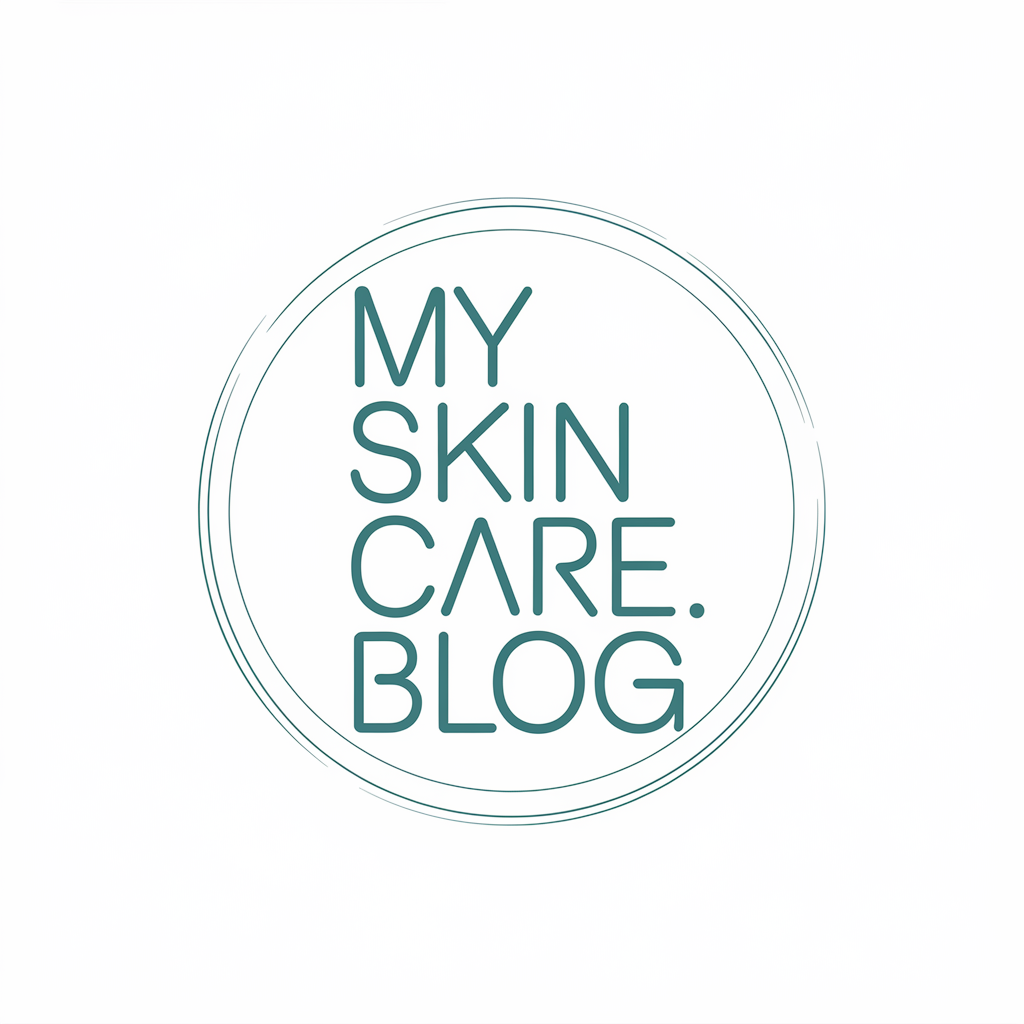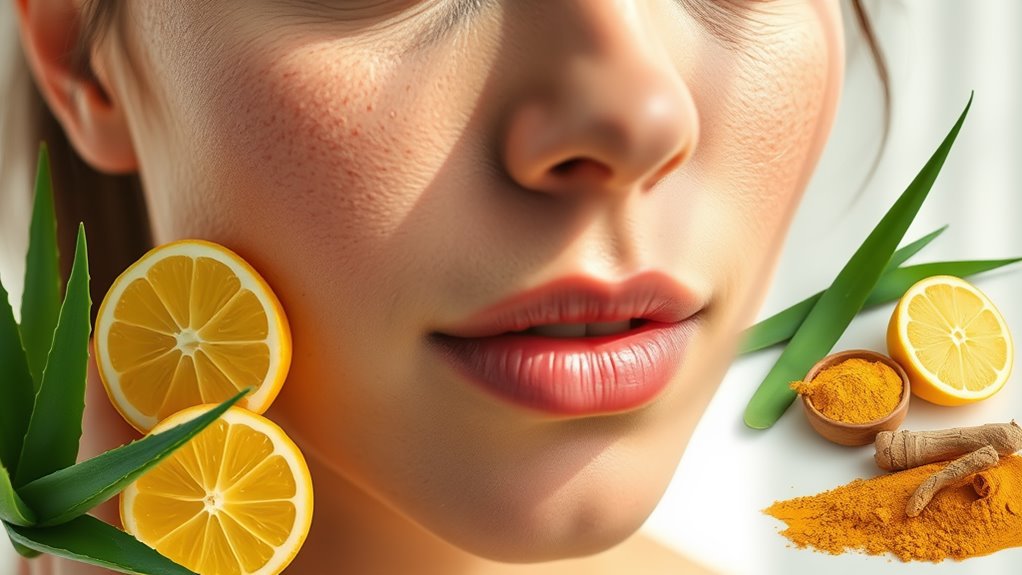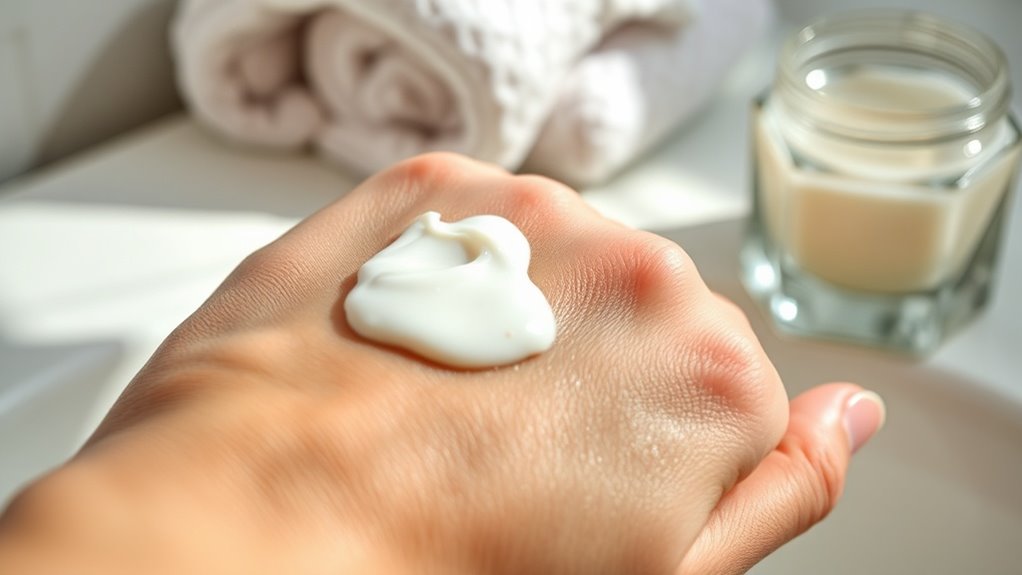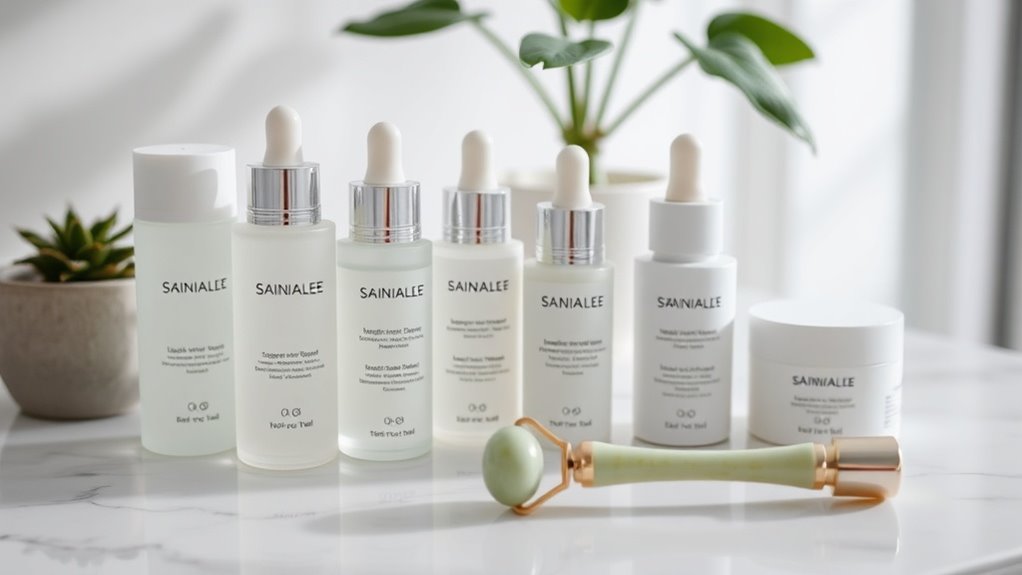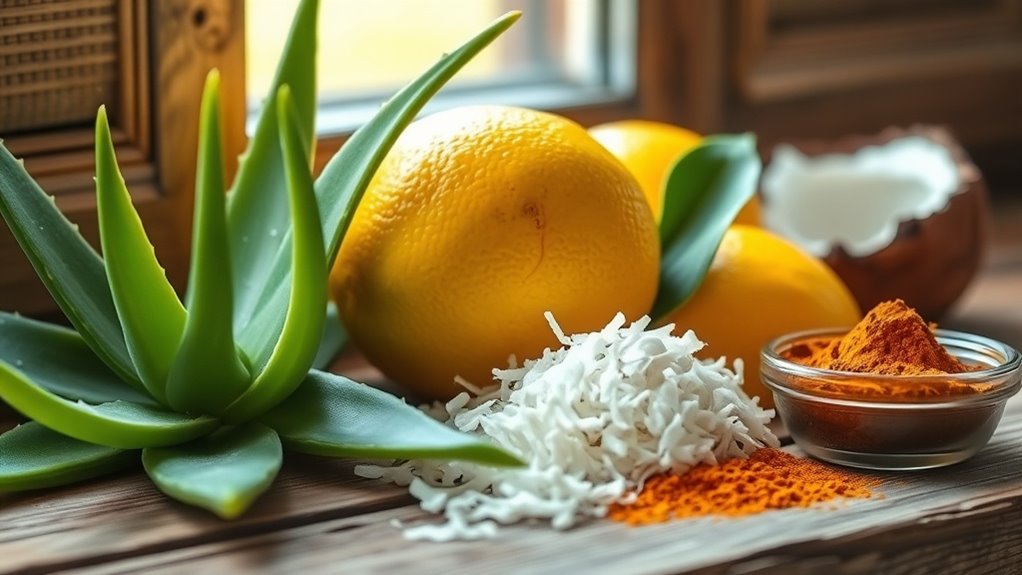The Real Reason Behind Dark Spots (And How to Fade Them Naturally)
Dark spots form when excessive sun exposure or hormonal changes trigger your skin’s overproduction of melanin, leading to uneven pigmentation from UV damage or inflammation. To fade them naturally, apply vitamin C-rich lemon juice or anti-inflammatory turmeric regularly, as these inhibit melanin and promote healing. By incorporating these remedies with sun protection, you’ll gradually achieve clearer skin, and explore further tips on types and prevention in the sections ahead.
Key Takeaways
- Dark spots arise mainly from excessive sun exposure, hormonal changes, and inflammation, causing melanin overproduction.
- Sun spots and age spots result from UV damage, while post-acne marks stem from skin inflammation.
- Apply natural remedies like lemon juice or turmeric to inhibit melanin and reduce hyperpigmentation.
- Incorporate vitamin C-rich foods and omega-3 fatty acids into your diet to support skin repair and fading.
- Use daily broad-spectrum SPF and consistent routines to prevent new dark spots and enhance natural fading.
Common Causes of Dark Spots
While dark spots often stem from environmental and internal factors, the most common causes include excessive sun exposure, which boosts melanin production, as well as hormonal fluctuations during pregnancy or menopause.
You produce more melanin when UV rays damage your skin cells, leading to these stubborn patches.
It’s also crucial to recognize that inflammation from acne or injuries triggers excess pigmentation. By identifying these triggers, you’re taking the first step toward a dark spots solution—empowering yourself with knowledge to prevent further damage. Moreover, exploring at-home remedies can offer accessible options for addressing hyperpigmentation alongside prevention strategies.
Fortunately, you can effectively address these dark spots by incorporating a DIY solution that utilizes natural ingredients and methods to reduce hyperpigmentation.
Identifying Different Types of Dark Spots
As you explore dark spots on your skin, you’ll recognize key types like sun spots, age spots, and post-acne marks, each stemming from specific triggers.
You can identify these by noting their appearance and location, which guides your approach to treatment.
Understanding these distinctions empowers you to select targeted natural remedies for clearer skin. For instance, incorporating Vitamin C can help address hyperpigmentation caused by these spots through its antioxidant properties.
Additionally, for post-acne marks, incorporating natural remedies from proven techniques can effectively fade these scars and improve skin texture.
Sun Spots
Sun spots, often called solar lentigines, are flat, pigmented lesions that develop on your skin from prolonged UV exposure. This happens when UV rays stimulate melanocytes to overproduce melanin, creating darkened patches.
You’ll typically spot them on sun-exposed areas like your face, hands, and shoulders, appearing as small, round or oval spots in shades of tan, brown, or black. They’re uniform in color with well-defined borders, distinguishing them from irregular marks.
While benign, these spots signal cumulative sun damage. You can identify them by examining your skin regularly under good light, empowering you to take proactive steps for protection.
Age Spots
Age spots, often called liver spots, develop on your skin as you age, mainly from long-term UV exposure and genetics.
These flat, tan, brown, or black patches typically appear on sun-exposed areas like your face, hands, and arms, resulting from melanin overproduction in response to cumulative sun damage.
You might notice them more if you have a family history, as genetics influence your skin’s vulnerability.
To identify them accurately, compare with other spots; they’re benign but signal photoaging.
Regularly examine your skin and consult a dermatologist for proper assessment, helping you understand your unique risk factors.
Post-Acne Marks
Post-acne marks form after acne clears and represent another common dark spot type linked to skin inflammation.
You might notice these as hyperpigmented patches, like red or brown spots, that linger on your skin. These marks, often called PIH (post-inflammatory hyperpigmentation), occur when your body’s melanin production surges in response to healed acne lesions.
To identify them, check for flat, discolored areas that don’t fade quickly—unlike scars, they’re not raised. Scientifically, they stem from melanocyte overactivity, triggered by inflammation.
For natural fading, you can use antioxidants like vitamin C to inhibit melanin and promote even skin tone, restoring your complexion’s clarity.
Natural Ingredients for Fading Dark Spots
You can harness the power of natural ingredients like lemon juice to fade dark spots, as its high vitamin C content helps inhibit melanin production and brighten your skin. For enhanced skin benefits, try a DIY Face Mask that uses simple kitchen ingredients to promote overall radiance.
Turmeric offers effective spot remedies through its curcumin compound, which reduces inflammation and promotes even skin tone when applied topically.
Evidence from my before-and-after results demonstrates the effectiveness of these natural ingredients in reducing hyperpigmentation.
Lemon Juice Benefits
Lemon juice, with its rich vitamin C content, effectively brightens skin and targets dark spots by acting as a natural antioxidant.
You can harness its power by applying a diluted mixture to affected areas, where it inhibits melanin production and promotes cell turnover. This reduces hyperpigmentation over time, giving you a more even complexion.
Always perform a patch test first, as its acidity may irritate sensitive skin—dilute with water to minimize risks.
For optimal results, incorporate it into your nightly routine, but protect your skin from sun exposure afterward to prevent further darkening.
Consistency is key; you’ll notice gradual improvements in weeks.
Turmeric Spot Remedies
Turmeric, renowned for its curcumin compound, serves as a potent natural remedy for fading dark spots by inhibiting melanin production and reducing inflammation.
You’ll harness its antioxidant power to brighten your skin effectively. By using turmeric regularly, you can achieve noticeable results.
Here’s how to incorporate it:
-
Mix turmeric with raw honey into a smooth paste, envisioning the vibrant yellow blend soothing your troubled areas like a golden elixir.
-
Apply the mixture to dark spots on your face, picturing curcumin’s molecules actively blocking melanin for a clearer complexion.
-
Let it sit for 15 minutes, then rinse, imagining inflammation melting away as your skin reveals a fresher, even tone.
Simple Home Remedies to Reduce Pigmentation
While pigmentation issues often stem from factors like sun exposure or inflammation, simple home remedies can effectively lighten dark spots using everyday ingredients. For added relief from associated skin irritation, try applying cold compresses as a simple method to soothe the affected areas.
You can harness aloe vera’s aloin compound, which inhibits melanin production—apply fresh gel twice daily for its anti-inflammatory effects.
Alternatively, lemon juice’s citric acid gently exfoliates; dilute it with honey to avoid irritation, as honey provides antibacterial benefits.
Potato slices offer catecholase enzymes that break down pigmentation; rub them on spots for 10 minutes.
Additionally, avoiding excessive sugar intake from your diet can prevent worsening of dark spots, as it contributes to inflammation and skin damage.
Test on a small area first, and use these consistently for noticeable results, backed by natural science.
Lifestyle Changes for Even Skin Tone
Achieving an even skin tone requires more than topical treatments; you must adopt lifestyle habits that support your skin’s health from within.
These changes target melanin production and cellular repair for lasting results. Here’s how you can visualize and implement them:
-
Prioritize sun protection*: You step outside with *broad-spectrum SPF, shielding your skin from UV rays that trigger pigmentation, fostering a uniform complexion under the sun’s glare. For better defense against UV damage, opting for a higher SPF level can provide additional protection based on your exposure.
-
Incorporate regular exercise****: You engage in daily activities like brisk walking, boosting circulation to deliver oxygen and nutrients, imagining your skin glowing with renewed vitality.
-
Manage stress effectively: You practice mindfulness or yoga routines, reducing cortisol levels that exacerbate dark spots, picturing a calm state where your skin heals seamlessly.
Furthermore, integrating daily sunscreen into your routine is essential, as it prevents premature aging by blocking harmful UV rays and supports overall skin health.
Dietary Tips to Support Skin Health
Beyond lifestyle habits that nurture your skin from within, you optimize its health by selecting nutrient-rich foods that influence melanin regulation and cellular repair.
Prioritize vitamin C from citrus fruits and berries to neutralize free radicals and inhibit melanin overproduction. Incorporate beta-carotene from carrots and sweet potatoes, which supports cellular regeneration and protects against oxidative damage. Additionally, focus on collagen production through foods like bone broth to further support skin elasticity and firmness.
Add omega-3 fatty acids from fatty fish like salmon to reduce inflammation and promote even tone. Include zinc from legumes and nuts to enhance enzyme activity for skin repair, ensuring a balanced intake for sustained radiance.
By documenting your own personal journey with these dietary adjustments, you can observe the visible impact on your complexion over time.
Preventive Measures for Long-Term Skin Clarity
To achieve long-term skin clarity, you protect your complexion by consistently shielding it from UV rays and environmental aggressors. This involves adopting science-backed routines that bolster your skin’s barrier and reduce pigmentation risks.
Focus on these preventive strategies:
-
Apply broad-spectrum SPF daily*: Imagine a *protective veil forming as you layer sunscreen, blocking UVA/UVB rays that trigger melanin overproduction and dark spots.
-
Incorporate antioxidant-rich products*: Visualize free radicals being *neutralized like tiny shields, as serums with vitamin C or E combat oxidative stress from pollution.
-
Maintain a gentle skincare regimen****: Picture your skin as a fortified wall, with mild cleansers and moisturizers preserving its pH balance to prevent inflammation and future discoloration.
